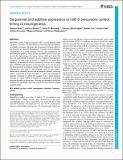Files in this item
Sequential and additive expression of miR-9 precursors control timing of neurogenesis
Item metadata
| dc.contributor.author | Soto, Ximena | |
| dc.contributor.author | Burton, Joshua | |
| dc.contributor.author | Manning, Cerys S. | |
| dc.contributor.author | Minchington, Thomas | |
| dc.contributor.author | Lea, Robert | |
| dc.contributor.author | Lee, Jessica | |
| dc.contributor.author | Kursawe, Jochen | |
| dc.contributor.author | Rattray, Magnus | |
| dc.contributor.author | Papalopulu, Nancy | |
| dc.date.accessioned | 2022-10-25T16:30:18Z | |
| dc.date.available | 2022-10-25T16:30:18Z | |
| dc.date.issued | 2022-10-01 | |
| dc.identifier | 281864590 | |
| dc.identifier | d73ad32a-0c82-4b29-8054-3254b062c517 | |
| dc.identifier | 85139100943 | |
| dc.identifier | 000918161000003 | |
| dc.identifier.citation | Soto , X , Burton , J , Manning , C S , Minchington , T , Lea , R , Lee , J , Kursawe , J , Rattray , M & Papalopulu , N 2022 , ' Sequential and additive expression of miR-9 precursors control timing of neurogenesis ' , Development , vol. 149 , no. 19 , dev200474 . https://doi.org/10.1242/dev.200474 | en |
| dc.identifier.issn | 0950-1991 | |
| dc.identifier.other | Jisc: 637442 | |
| dc.identifier.other | publisher-id: dev200474 | |
| dc.identifier.other | ORCID: /0000-0002-0314-9623/work/121753850 | |
| dc.identifier.other | PubMedCentral: PMC9641661 | |
| dc.identifier.uri | https://hdl.handle.net/10023/26243 | |
| dc.description | Funding: This work was supported by a Wellcome Trust Senior Research Fellowship (090868/Z/09/Z) and a Wellcome Trust Investigator Award (224394/Z/21/Z) to N.P. and a Medical Research Council Career Development Award to C.S.M. (MR/V032534/1). J.B. was supported by a Wellcome Trust Four-Year PhD Studentship in Basic Science (219992/Z/19/Z). Open Access funding provided by The University of Manchester. | en |
| dc.description.abstract | MicroRNAs (miRs) have an important role in tuning dynamic gene expression. However, the mechanism by which they are quantitatively controlled is unknown. We show that the amount of mature miR-9, a key regulator of neuronal development, increases during zebrafish neurogenesis in a sharp stepwise manner. We characterize the spatiotemporal profile of seven distinct microRNA primary transcripts (pri-mir)-9s that produce the same mature miR-9 and show that they are sequentially expressed during hindbrain neurogenesis. Expression of late-onset pri-mir-9-1 is added on to, rather than replacing, the expression of early onset pri-mir-9-4 and -9-5 in single cells. CRISPR/Cas9 mutation of the late-onset pri-mir-9-1 prevents the developmental increase of mature miR-9, reduces late neuronal differentiation and fails to downregulate Her6 at late stages. Mathematical modelling shows that an adaptive network containing Her6 is insensitive to linear increases in miR-9 but responds to stepwise increases of miR-9. We suggest that a sharp stepwise increase of mature miR-9 is created by sequential and additive temporal activation of distinct loci. This may be a strategy to overcome adaptation and facilitate a transition of Her6 to a new dynamic regime or steady state. | |
| dc.format.extent | 14 | |
| dc.format.extent | 9348839 | |
| dc.language.iso | eng | |
| dc.relation.ispartof | Development | en |
| dc.subject | pri-mir-9 | en |
| dc.subject | miR-9 | en |
| dc.subject | Neurogenesis | en |
| dc.subject | Zebrafish | en |
| dc.subject | Temporal control | en |
| dc.subject | QH301 Biology | en |
| dc.subject | DAS | en |
| dc.subject | MCC | en |
| dc.subject.lcc | QH301 | en |
| dc.title | Sequential and additive expression of miR-9 precursors control timing of neurogenesis | en |
| dc.type | Journal article | en |
| dc.contributor.institution | University of St Andrews. Statistics | en |
| dc.contributor.institution | University of St Andrews. Applied Mathematics | en |
| dc.identifier.doi | 10.1242/dev.200474 | |
| dc.description.status | Peer reviewed | en |
This item appears in the following Collection(s)
Items in the St Andrews Research Repository are protected by copyright, with all rights reserved, unless otherwise indicated.

